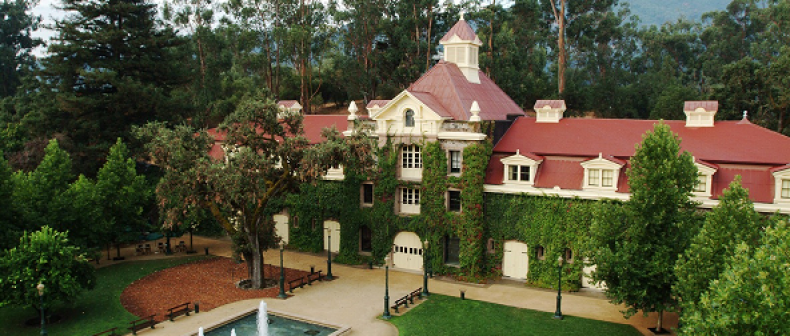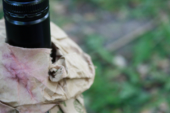
This is part two of our story on Francis Ford Coppola’s Inglenook Vineyard. Part one ran last Thursday.
The John Daniel Jr. Era
John Daniel is the next great character in the Inglenook story. He graduated from Stanford in 1933 and returned to the estate to learn about viticulture and wine making. Upon his inheritance from his great aunt in 1936, he became the General Manager of Inglenook. His stated aim of “pride, not profit,” echoed the uncompromising approach of his great uncle the Captain. Daniel resumed production of estate bottled wines in the post Great Depression period, bottling only what he deemed acceptable quality and refusing to sell the product of inferior vintages under the Inglenook label. He was also among the first to consistently use the designation “Napa Valley” on his wines, helping to re-establish not only the Inglenook but also the reputation of the region. The wine was as good as ever, and Daniel’s legendary 1941 Inglenook Cabernet is considered one of the greatest red wines ever produced in the United States, with some pundits even rating it equal to the legendary vintages of top Bordeaux Chteau.
Although the period between 1933 and 1964 is considered the golden era for Inglenook, quality came at the expense of profit. Daniel’s daughter Robin would later reveal that not a penny was made at the estate until 1963, the year before Daniel felt compelled to sell part of the property in order to save it. The chteau and the vineyards at the front of the property were sold to United Vintner’s for $1.2-million, with the condition that the integrity of the estate and the Inglenook name would remain intact. Corporate greed, however, resulted in a very different outcome. After 85 years of building a reputation for quality, the end of Inglenook was at hand.
Wine continued to be made at the estate, but Inglenook was appropriated as a brand name to be used on generic jug wines produced from United Vintner’s Central Valley vineyards. Eventually, the Inglenook estate was sold off in 1969 to Heublein, a major spirits company that continued the downward spiral. Quality grapes were ripped out for more profitable generic varieties, and pesticides were introduced that had never before been used in the vineyards. John Daniel Jr. died in 1971, and his widow decided to sell the part of the estate that had remained in the family. The disintegration of Inglenook was complete.
The Francis Ford Coppola Era
Wine on the Coppola family table, was, as for many Italian immigrant families, ever-present, and Coppola fondly remembers winemaking in his grandfather’s basement. As an increasingly successful scriptwriter and director, there was little time to consider winemaking, though an attraction to own a few vines was admittedly there. His first contact with the Inglenook property came in the early ‘70s. With a little Hollywood success under his belt, he and his wife Eleanor considered purchasing a summer cottage outside of San Francisco. Their real estate agent suggested they check out the Niebaum Mansion in Napa, which was up for auction. It was far more than they were looking for, but they were struck by the natural beauty of the place and the intriguing history behind it. “The first impression is beauty”, says Coppola of the estate, “and beauty is seductive”. They put in a bid.
It was, as it turns out, well short of the selling price; the winning bid went instead to a consortium of property developers with plans to build houses on the hill behind the house. That would truly have been the end of the historic property had the newly formed Land Trust of Napa not stepped in to declare the are an agricultural preserve and thus protect it from urban development. Three years later the ‘back part’ of the old Niebaum estate was up for sale again, and this time, after the success of The Godfather Part One (1972) and Part Two (1974), Coppola wouldn’t be outbid. He acquire the 1700 acre estate including the old Niebaum mansion and 110 acres of Rutherford vineyards. At $2-million the property certainly wasn’t cheap, but this was before the famous Paris tasting of 1976, when California wines topped the best of Bordeaux and the Napa Valley was firmly put on the international winemaking map. Prices have risen pretty much ever since.
Coppola’s goal from the beginning was to restore the image of this historic property. He re-named the estate “Niebaum-Coppola” in the tradition of Bordeaux. The first harvest was 1978, a blend of cabernet sauvignon, franc and merlot that would be released in 1983 under the proprietary name Rubicon. The name was a reference to Caesar’s crossing of the Rubicon, the famous point of no return on his campaign, an apt metaphor for Coppola’s project.
In 1995, Coppola managed to purchase the original front property along with the Inglenook chateau, thanks in no small measure to the success of Bram Stoker’s Dracula film. In 2002, he purchased the J.J. Cohn vineyard south of the main property, restoring the original dimension of the estate. In that year winemaking also returned to the chateau for the first time in three and half decades.
The last piece of the puzzle was the Inglenook name. After several years of negotiation, Coppola managed to secure the rights to the historic name of the property for use on estate grown wines. He’s not able to disclose the exact sum paid for the same, but was able to reveal that “it was in excess of $14-million.” All in all, Coppola’s quest to restore Inglenook spanned 37 years and cost well over $60-million, but as of 2011, all of the original vineyards, the cellar, the mansion and lastly but perhaps most importantly the Inglenook name are once again all owned by a single, purpose-driven individual. Quality has been on top form for many years now, and set to get even better under the guidance of Philippe Bascaules, the recently hired Managing Director of the Inglenook Estate. Bascaules comes with 21 years of making wine at the Bordeaux First Growth Chteau Margaux, and knows nothing other than quality at the very top echelon.
There’s much more to look forward to it, seems, in the next chapter of the Inglenook story.
—–
John Szabo is a master sommelier and wine writer for Toronto Standard. Follow his tweets here: @johnszabo.
More recommendations by John Szabo at www.johnswines.com
For more, follow us on Twitter @TorontoStandard and subscribe to our newsletter.














